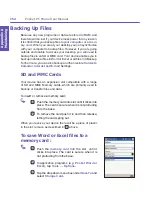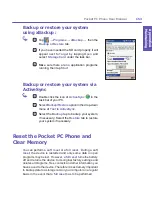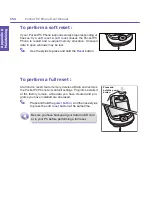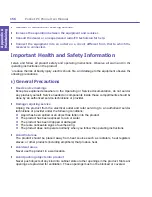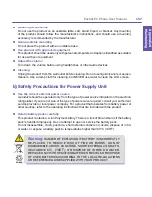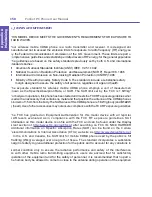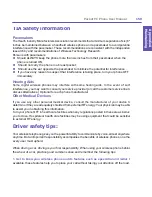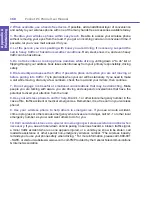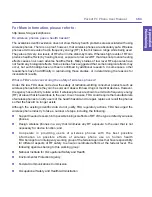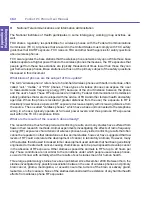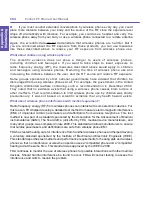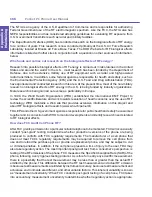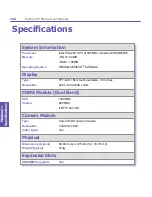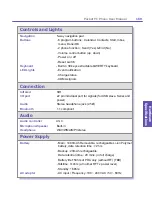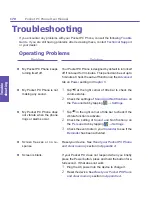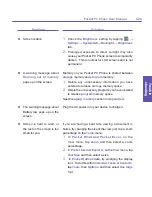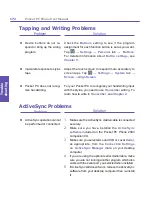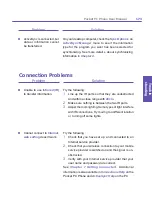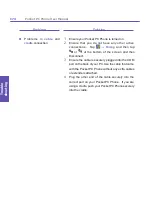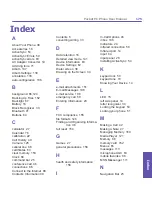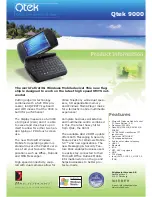
Appendix A Maintaining
Pocket PC Phone User Manual
166
Appendix A
Maintaining
Pocket PC Phone User Manual
167
The NTIA is an agency of the U.S. Department of Commerce and is responsible for authorizing
Federal Government use of the RF electromagnetic spectrum. Like the FCC, the NTIA also has
NEPA responsibilities and has considered adopting guidelines for evaluating RF exposure from
U.S. Government transmitters such as radar and military facilities.
The Department of Defense (DOD) has conducted research on the biological effects of RF energy
for a number of years. This research is now conducted primarily at the U.S. Air Force Research
Laboratory located at Brooks Air Force Base, Texas. The DOD Web site for RF biological effects
information is listed with other sites in conjunction with a question on other sources of information,
below.
Who funds and carries out research on the biological effects of RF energy?
Research into possible biological effects of RF energy is carried out in laboratories in the United
States and around the world. In the U.S., most research has been funded by the Department of
Defense, due to the extensive military use of RF equipment such as radar and high-powered
radio transmitters. In addition, some federal agencies responsible for health and safety, such as
the Environmental Protection Agency (EPA) and the U.S. Food and Drug Administration (FDA),
have sponsored and conducted research in this area. At the present time, most of the non-military
research on biological effects of RF energy in the U.S. is being funded by industry organizations.
More research is being carried out overseas, particularly in Europe.
In 1996, the World Health Organization (WHO) established the International EMF Project to
review the scientific literature and work towards resolution of health concerns over the use of RF
technology. WHO maintains a Web site that provides extensive information on this project and
about RF biological effects and research (www.who.ch/peh-emf).
FDA, EPA and other US government agencies responsible for public health and safety have worked
together and in connection with WHO to monitor developments and identify research needs related
to RF biological effects.
How does FCC Audit Cell Phone RF?
After FCC grants permission for a particular cellular telephone to be marketed, FCC will occasionally
conduct “post-grant” testing to determine whether production versions of the phone are being
produced to conform with FCC regulatory requirements. The manufacturer of a cell phone that
does not meet FCC’s regulatory requirements may be required to remove the cell phone from
use and to refund the purchase price or provide a replacement phone, and may be subject to civil
or criminal penalties. In addition, if the cell phone presents a risk of injury to the user, FDA may
also take regulatory action. The most important post-grant test, from a consumer’s perspective, is
testing of the RF emissions of the phone. FCC measures the Specific Absorption Rate (SAR) of the
phone, following a very rigorous testing protocol. As is true for nearly any scientific measurement,
there is a possibility that the test measurement may be less than or greater than the actual RF
emitted by the phone. This difference between the RF test measurement and actual RF emission
is because test measurements are limited by instrument accuracy, because test measurement and
actual use environments are different, and other variable factors. This inherent variability is known
as “measurement uncertainty.” When FCC conducts post-grant testing of a cell phone, FCC takes
into account any measurement uncertainty to determine whether regulatory action is appropriate.
Summary of Contents for PDA2K EVDO
Page 1: ...Pocket PC Phone...
Page 2: ...Pocket PC Phone User Manual 2...
Page 13: ...Chapter 1 Getting Started 1 1 Knowing Your Device 1 2 Battery 1 3 Accessories...
Page 20: ...Getting Started Pocket PC Phone User Manual 20...
Page 52: ...Pocket PC Phone User Manual 52 Using Your Phone...
Page 60: ...Pocket PC Phone User Manual 60 Synchronizing Information...
Page 61: ...Chapter 5 Personalizing Your Pocket PC Phone 5 1 Device Settings 5 2 Phone Settings...
Page 74: ...Pocket PC Phone User Manual 74 Personalizing...
Page 125: ...Chapter 10 Using Your Camera 10 1 Before Using the Camera 10 2 Camera 10 3 Album...
Page 146: ...Pocket PC Phone User Manual 146 Using Your Camera...

